November 2023 Newsletter
Ashley Nichols - Nov 15, 2023
This month we share some insights rates and how they affect different aspects of our finances in even more different ways. Ashley provides a fun article on behalf of her Millennial Minute, and Stephen gives his Technical Comments on the market.

Money is a tool. It's something that supports your life!
We've moved!
Life continues changing at BMO Nesbitt Burns, and we've moved to a new office space!
We are now located at the Enbridge Centre, just across the street from our Manulife location.
10175 1 101 St. NW, 19th floor, Edmonton AB T5J 0H3
For clients who wish to come for in-office meetings, parking is still at Manulife Place, and we will still validate for 2 hours.
Photo Contest Winner!

It doesn't get much more Fall Fabulous than this!
We want to thank everyone for taking part in our photo contests this year! Even if you didn't win our gift cards, your photos were well received by the team, and we loved seeing your beautiful shots and memories!
The winner this month will receive a $100 gift card to a local restaurant, and stay tuned in 2024 for another chance to win!
Investment Planning
It's all about those rates...
Violence, political turmoil and rising interest rates have unfortunately characterized much of 2023. As a result, it's no surprise that investors are feeling pessimistic, and a substantial portion of the market is facing downward pressure. While examining conflicts in the Middle East, Ukraine, and other less-publicized regions like Sudan and Yemen, we have consistently held the view that external shocks typically don't have a long-lasting impact on the market. Instead, the economic cycle and interest rates are the primary drivers of financial asset returns.
Nevertheless, the paramount factor in this equation is the trajectory of long-term interest rates. In fact, investors have become fixated on the 10-year U.S. Treasury rates, which serve as the linchpin for all financial markets. Recently, these rates crossed the psychologically significant 5% threshold, having started the year at 3.5%. This is the highest level in over 15 years. This matters because bond prices move inversely to interest rates, and long-term bonds are particularly vulnerable. Stocks are also affected by higher rates, albeit indirectly. The primary reason for this is that elevated rates reduce the present value of future cash flows, making stock dividend yields less appealing compared to lower-risk government bonds. However, there's a silver lining, as this dynamic can also work in reverse, and we believe we may have reached a near-term peak in yields.
We anticipate that we are on the cusp of entering a period of greater interest rate stability. The Bank of Canada (BoC) and the Federal Reserve (Fed) seem to have adopted a more cautious stance, with a potential final rate increase on the horizon. Our analysis has shown that the market tends to perform well when interest rates remain stable. This aligns with historical trends, as traders and investors have consistently rewarded visibility and stability with higher asset valuations.
Higher interest rates are not necessarily detrimental for fixed income investors. They can anticipate reduced reinvestment risk, higher income, and greater returns. What has been disconcerting is the rapid pace at which rates have climbed, which poses challenges for investors with longer time horizons. Understanding the contributing factors behind this recent surge in rates may alleviate some of these concerns. Over nearly two years, short-term rates adjusted to expectations of higher policy rates, which resulted in a yield curve inversion as short-term rates surpassed long-term rates. However, the roles have started to reverse since last summer, with mid- to long-term rates leading the upward trend, driven by four primary factors: a robust U.S. economy, persistent inflation, central banks adopting a more hawkish stance, and fiscal policy changes.
When the Federal Reserve aggressively raises rates, the primary concern is inadvertently triggering a significant market downturn. This is why we have increased the cash allocation in our portfolios. There is typically a time lag between the start of Fed rate hikes and the onset of recessions, and this lag period is approximately ten quarters.
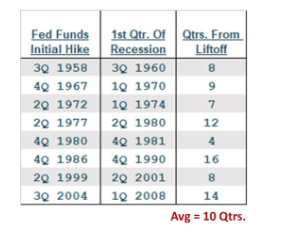
We are starting to see early indication of a recession; we’re seeing employment and housing start to weaken and long rates have dropped. The 10-year has been the key driver for equity market weakness since the correction began in the summer and it has definitively reversed back to the downside this week accompanied by new sell signals in short and medium-term momentum gauges. First support is the 50-day moving average at 4.55% then the breakout across 4.34%. The last few times medium-term momentum gauges rolled over from such steep overbought extremes though, it resulted in the 10-year coming all the way back to its 200-day moving average which is currently at 3.92%. That will be a massive tailwind for equities if that’s what transpires. In addition, we are now in the seasonal “sweet spot” for equity markets. Historically, November is the best month of the year for both the TSX and the S&P 500. Not only that, but the November to January period is the strongest consecutive three months of the year with average returns of 4.30% for the S&P 500 and 4.33% for the TSX.
The most efficient way to play that run is through exchange traded funds not individual stocks.
The game plan is to have a larger percentage of the accounts in index funds until the markets tops then sell the index funds and bring down our individual stock weighting to 20%. At the same time, we intend to raise cash and increase our bond weightings. Once the recession starts, we think the Fed will be very slow in cutting rates due to their fear of stoking inflation, causing a deeper recession. When all the headlines are negative, and no one wants to buy stocks, we will be more than happy to buy them at bargain prices.
We will closely follow the price action in the markets to implement this strategy because there is a chance we are completely wrong, and the market stages a V recovery and rockets to new highs. If the price action tells us the markets are heading higher, we will go along for the ride.
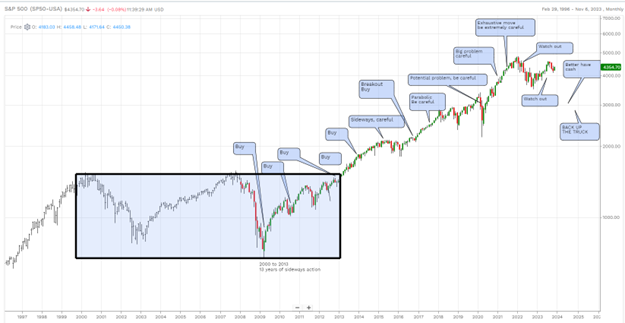
Our Portfolio
*Hopefully everyone has had a chance to listen to our Podcast last month where we covered interest rates, housing, consumer debts and how they can affect your financial plan.*
Transactions
During the month we trimmed some of the Canadian and US stocks and started a tactical position in TLT - 20yr Treasury Bond EFT. It is currently around 5% of the accounts and is already up 5%. We are currently around 25% cash, 25% bonds and 50% equity.
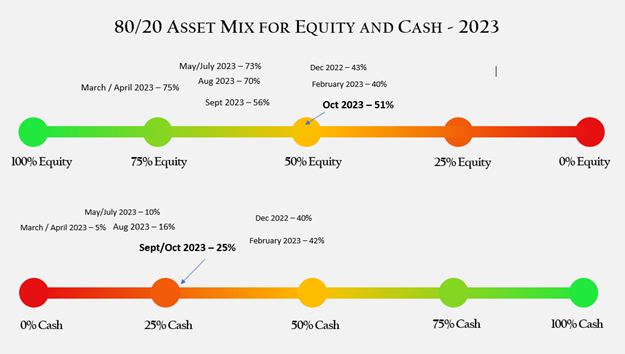
Returns on our 60/40, 70/30 and 80/20 portfolios before fees:
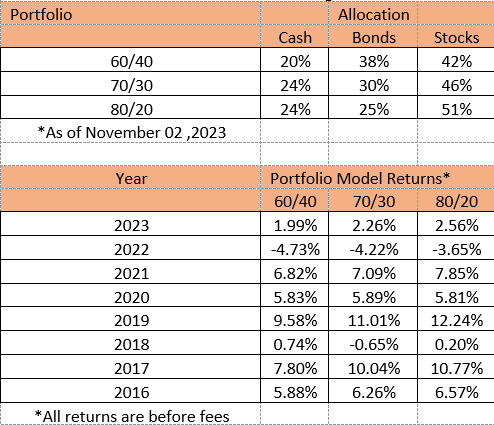
Interesting Charts
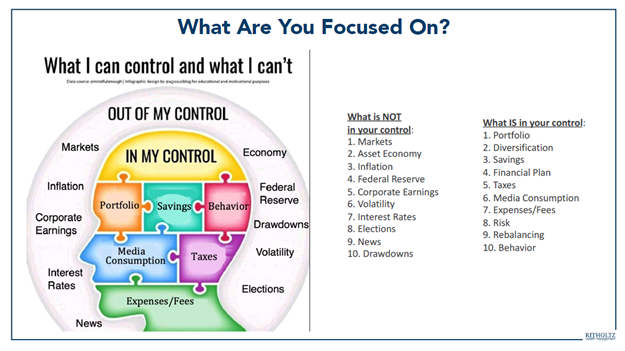
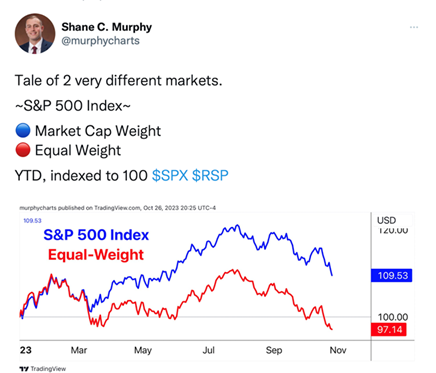
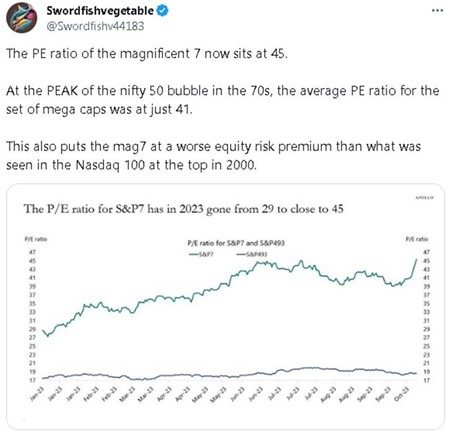
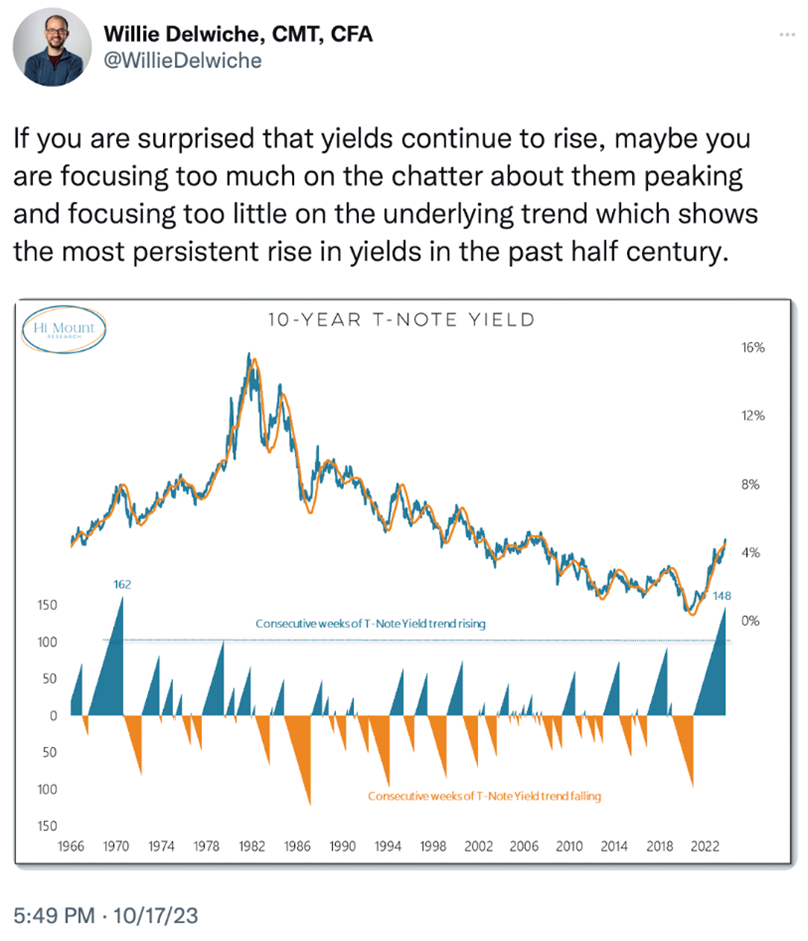
Technical Comments
https://www.brookstradingcourse.com/price-action-trading-blog/
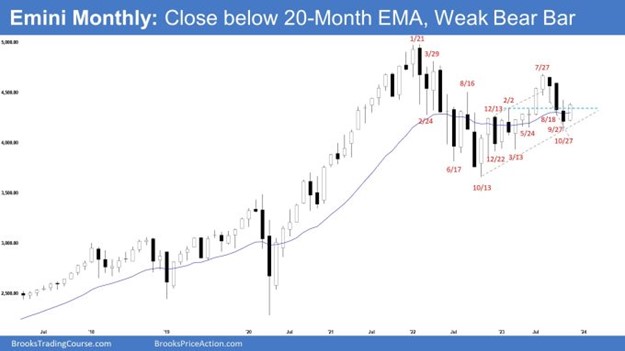
The October monthly S&P 500 candlestick was a bear bar with long tails above and below.
Last month, we said that the Emini may still trade at least a little lower and traders will see if the bears can create follow-through selling closing below the 20-month EMA.
October traded lower and closed below the 20-month EMA. However, the long tail below the candlestick indicates that the bears are not as strong as they would like to be.
The bears see the prior rally (Jul 27) as a retest of the all-time high and want a reversal from a lower high major trend reversal.
They got 3 consecutive bear bars, something that has not happened since the January 2020 selloff. The last time the S&P 500 formed 4 consecutive bear bars was in the year 2011. Can the bears create another consecutive bear bar?
The bears will need to create follow-through selling closing far below the 20-month EMA to increase the odds of a reversal down.
Previously, the bulls managed to create a tight bull channel from March to July.
That increases the odds of at least a small second leg sideways to up after the recent pullback.
They see the pullback from August to October simply as a 50% pullback of the whole rally which started in October 2022.
They want the market to reverse up from a trend channel line overshoot (Oct) and a higher low, retesting the July 27 high followed by a breakout above.
So far, November started with strength and is currently an inside bull bar.
If November closes as a bull bar near its high and above October’s high, that will increase the odds of the bull trend resuming.
The bears want November to close with a long tail above and a bear body.
For now, the bull trend remains intact (higher highs, higher lows).
Millennial Minute
Happy November everyone! Sometimes the month seems to run away on me, and this month seems to be one of them!
I will be back in our next newsletter with another article to share with you! And don't forget to share any information you may find useful with your kids, grandkids, or anyone who may be struggling with today's financial struggles.
In the meantime - I will share today an article by Michael Hobbes, published by the Huffington Post. It was created in 2018, however, I do believe the bulk of the article still rings true for many millennials and gen z today.
It's also a very fun article to scroll through! Just keep holding down the  arrow on your keyboard to enjoy the articles animations!
arrow on your keyboard to enjoy the articles animations!
Click here to read "Poor Millennials" by Michael Hobbes
(these are the thoughts and opinions of the author of this article and don't necessarily reflect the opinions of The Biddle Johnston Wealth Management Team and/or BMO Nesbitt Burns Inc.)
Planning
The Health and Wealth Connection
A strong correlation exists between your health and your financial well-being. With good health, you may work longer, travel more, and engage in activities that improve your quality of life. In turn, these factors can also impact your earning power and saving potential.
